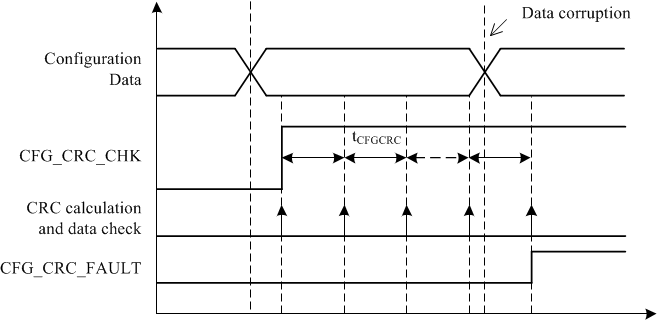JAJSKM1C october 2019 – september 2021 UCC5870-Q1
PRODUCTION DATA
- 1
- 1 特長
- 2 アプリケーション
- 3 概要
- 4 Revision History
- 5 Pin Configuration and Functions
- 6 Specifications
-
7 Detailed Description
- 7.1 Overview
- 7.2 Functional Block Diagram
- 7.3
Feature Description
- 7.3.1 Power Supplies
- 7.3.2 Driver Stage
- 7.3.3 Integrated ADC for Front-End Analog (FEA) Signal Processing
- 7.3.4 Fault and Warning Classification
- 7.3.5
Diagnostic Features
- 7.3.5.1 Undervoltage Lockout (UVLO) and Overvoltage Lockout (OVLO)
- 7.3.5.2 CLAMP, OUTH, and OUTL Clamping Circuits
- 7.3.5.3 Active Miller Clamp
- 7.3.5.4 DESAT based Short Circuit Protection (DESAT)
- 7.3.5.5 Shunt Resistor based Overcurrent Protection (OCP) and Short Circuit Protection (SCP)
- 7.3.5.6 Temperature Monitoring and Protection for the Power Transistors
- 7.3.5.7 Active High Voltage Clamping (VCECLP)
- 7.3.5.8 Two-Level Turn-Off
- 7.3.5.9 Soft Turn-Off (STO)
- 7.3.5.10 Thermal Shutdown (TSD) and Temperature Warning (TWN) of Driver IC
- 7.3.5.11 Active Short Circuit Support (ASC)
- 7.3.5.12 Shoot-Through Protection (STP)
- 7.3.5.13 Gate Voltage Monitoring and Status Feedback
- 7.3.5.14 VGTH Monitor
- 7.3.5.15 Cyclic Redundancy Check (CRC)
- 7.3.5.16 Configuration Data CRC
- 7.3.5.17 SPI Transfer Write/Read CRC
- 7.3.5.18 TRIM CRC Check
- 7.4 Device Functional Modes
- 7.5 Programming
- 7.6 Register Maps
- 8 Applications and Implementation
- 9 Power Supply Recommendations
- 10Layout
- 11Device and Documentation Support
- 12Mechanical, Packaging, and Orderable Information
7.3.5.16 Configuration Data CRC
When the device transitions to the ACTIVE state, the contents of configuration and control registers are protected by CRC engine. The configuration CRC is enabled using the CFG8[CRC_DIS] bit (CFG8). The registers protected by the CRC include:
- CFG1 - CFG11
- ADCCFG
- DOUTCFG
- GD_ADDRESS[GD_ADDR] (no MSB)
- SPITEST
- CONTROL1
- CONTROL2, excluding the MSB (CONTROL2[CLR_STAT_REG])
The CRC fault detection is performed every tCRCCFG (typically 2 ms). If the calculated CRC8 checksum for the configuration registers does not match the CRC8 checksum calculated upon entering the Active state, the STATUS2[CFG_CRC_PRI_FAULT] (for a primary side CRC fail, STATUS2) or the STATUS4[CFG_CRC_SEC_FAULT] (for a secondary side CRC fail, STATUS4) bit is set and, if unmasked, the nFLT1 output goes low. Additionally, for the secondary side CRC failure, the driver output is forced to the state defined by CFG11[FS_STATE_CFG_CRC_SEC_FAULT] (CFG11).
Diagnostics for the CRC check are available. Use the CONTROL1[CFG_CRC_CHK_PRI] (CONTROL1) to induce a CRC error on the primary side. CONTROL2[CFG_CRC_CHK_SEC] (CONTROL2) to induce a CRC error on the secondary side. Writing to any of the "RESERVED" bits in the configuration registers also induces a CRC fault.
 Figure 7-35 Configuration Data CRC Check
Timing
Figure 7-35 Configuration Data CRC Check
Timing